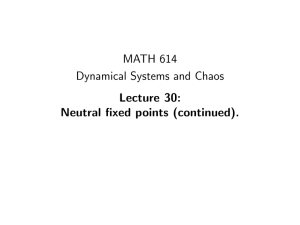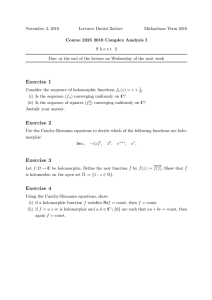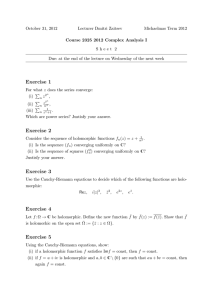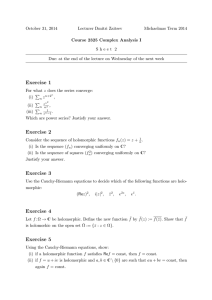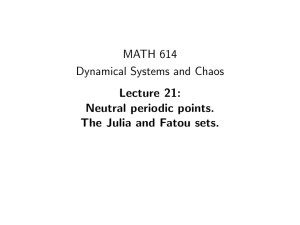MATH 614 Dynamical Systems and Chaos Lecture 29:
advertisement
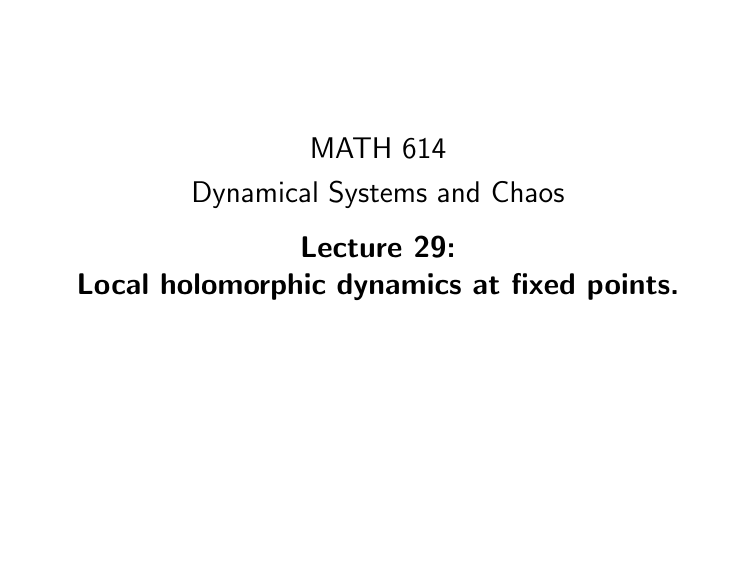
MATH 614
Dynamical Systems and Chaos
Lecture 29:
Local holomorphic dynamics at fixed points.
Classification of periodic points
Let U ⊂ C be a domain and F : U → C be a holomorphic
function. Suppose that F (z0 ) = z0 for some z0 ∈ U. The
fixed point z0 is called
• attracting if |F 0 (z0 )| < 1;
• repelling if |F 0 (z0 )| > 1;
• neutral if |F 0 (z0 )| = 1.
Now suppose that F n (z1 ) = z1 for some z1 ∈ U and an
integer n ≥ 1. The periodic point z1 is called
• attracting if |(F n )0 (z1 )| < 1;
• repelling if |(F n )0 (z1 )| > 1;
• neutral if |(F n )0 (z1 )| = 1.
The multiplier (F n )0 (z1 ) is the same for all points in the orbit
of z1 . In particular, all these points are of the same type as
z1 . Note that the multiplier is preserved under any
holomorphic change of coordinates.
Hyperbolic fixed points
Theorem 1 Suppose z0 is an attracting fixed point for a
holomorphic function F . Then there exist δ > 0 and
0 < µ < 1 such that
|F (z) − z0 | ≤ µ|z − z0 |
for any z ∈ D = {z ∈ C : |z − z0 | < δ}. In particular,
lim F n (z) = z0 for all z ∈ D.
n→∞
Theorem 2 Suppose z0 is a repelling fixed point for a
holomorphic function F . Then there exist δ > 0 and M > 1
such that
|F (z) − z0 | ≥ M|z − z0 |
for all z ∈ D = {z ∈ C : |z − z0 | < δ}. In particular,
for any z ∈ D \ {z0 } there is an integer n ≥ 1 such that
F n (z) ∈
/ D.
Theorem 3 Let F be a holomorphic function at 0 such that
F (0) = 0 and F 0 (0) = λ, where 0 < |λ| < 1. Then there is
a neighborhood U of 0 and a holomorphic map h : U → C
such that F ◦h = h◦L in U, where L(z) = λz.
Idea of the proof:
We are looking for a map h of the form
P
i
c
z
h(z) = z + ∞
i , where ci are unknown coefficients.
i =2 P
∞
Let F (z) = λz + i =2 ai z i be the Taylor expansion of F .
The condition F ◦h
X∞
X=∞h◦L holds if
ci λi z i
ai (h(z))i = λz +
λh(z) +
i =2
i =2
or, equivalently,
X∞
i =2
(λi − λ)ci z i =
X∞
i =2
ai (h(z))i .
From this equality of formal power series we can recursively
determine all coefficients ci . For example, c2 = a2 /(λ2 − λ).
Then one has to prove that the radius of convergence for the
power series h(z) is positive.
Theorem 4 Let F be a holomorphic function at 0
such that F (0) = 0 and F 0 (0) = λ, where |λ| > 1.
Then there is a neighborhood U of 0 and a
holomorphic map h : U → C such that F ◦h = h◦L
in L−1(U), where L(z) = λz.
Idea of the proof: Since F 0 (0) 6= 0, the function F
is invertible in a neighborhood of 0. The inverse
function F −1 is also holomorphic. The point 0 is an
attracting fixed point of F −1 .
It remains to apply the previous theorem.
Neutral fixed points
Example. • F (z) = z + z 2.
The map has a fixed point at 0, which is neutral: F 0 (0) = 1.
The set D0 of all points z satisfying F n (z) → 0 as n → ∞ is
open and connected.
The fixed point 0 is one of the cusp points at the boundary of
D0 . The others correspond to eventually fixed points.
Neutral fixed points
Proposition Suppose a function F is holomorphic at 0 and
satisfies F (0) = 0, F 0 (0) = 1, F 00 (0) = 2 so that
F (z) = z + z 2 + O(|z|3 ) as z → 0.
Then there exists µ > 0 such that (i) all points in the disc
D− = {z ∈ C : |z + µ| < µ} are attracted to 0; and (ii) all
points in the disc D+ = {z ∈ C : |z − µ| < µ} are repelled
from 0.
Proof: We change coordinates using the function
H(z) = 1/z, which maps the discs D− and D+ onto
halfplanes Re z < −1/(2µ) and Re z > 1/(2µ).
The function F is changed to G (z) = 1/F (1/z). Since
F (z) = z + z 2 + O(|z|3 ) as z → 0, it follows that
F (1/z) = z −1 + z −2 + O(|z|−3)
= z −1 1 + z −1 + O(|z|−2) as z → ∞.
Then
−1
G (z) = z 1 + z −1 + O(|z|−2)
= z 1 − z −1 + O(|z|−2) = z − 1 + O(|z|−1).
If µ is small enough, then the halfplane Re z < −1/(2µ) is
invariant under the map G while the halfplane Re z > 1/(2µ)
is invariant under G −1 .
The proposition suggests that for most of the points in a
neighborhood of 0, the forward and backward orbits under the
map F both converge to 0.
z
.
1−z
This is a Möbius transformation with 0 the only fixed point.
It follows that all forward and backward orbits converge to 0.
Examples. • F (z) =
• F (z) = z + z 2 .
The orbits of all points on the ray z > 0 converge to ∞ and
so are the orbits of all points in a small cusp about this ray.
In the proof of the proposition, we could use wedge-shaped
regions instead of halfplanes. This would allow to extend
basins of attraction from discs to cardioid-shaped regions.
In the case not all points near 0 are attracted to 0, the set of
points that are attracted is locally a simply connected domain
with 0 on its boundary. This domain is called the attracting
petal of the fixed point 0. Similarly, there is also the
repelling petal of 0.



